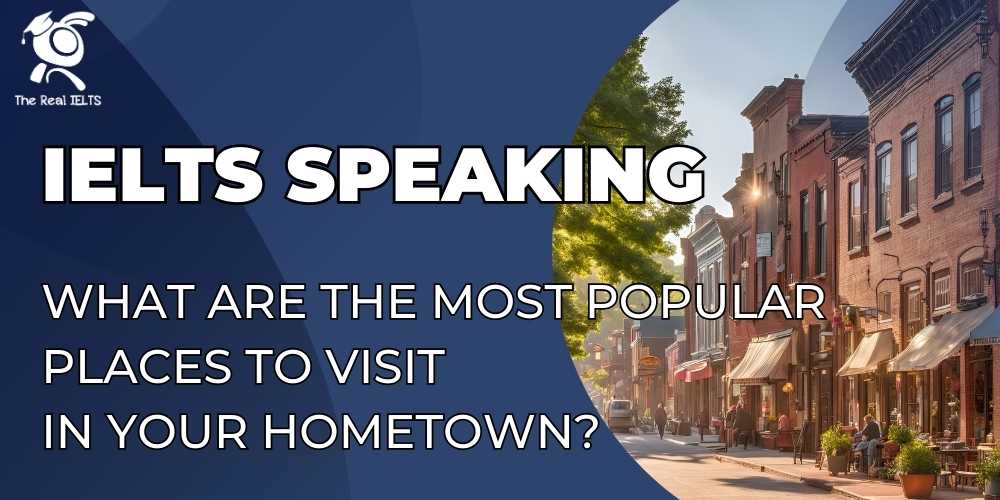Khám phá câu trả lời mẫu cho câu hỏi “What are the most popular places to visit in your hometown?” trong bài thi IELTS Speaking. Bài viết cung cấp từ vựng, cách diễn đạt ấn tượng, và ý tưởng thú vị để bạn tự tin chinh phục phần thi này.
Đọc thêm các bài luyện thi IELTS khác.
Đọc thêm câu hỏi khác tại: IELTS Speaking Part 1: Introduction and Interview chủ đề Your hometown.
Đọc thêm: IELTS Speaking: Do you think your hometown is a good place for tourists to visit?
Câu trả lời IELTS Speaking: What are the most popular places to visit in your hometown?
Ví dụ 1
Introduction:
In my hometown, Hanoi, the capital city of Vietnam, there are numerous fascinating places that attract both locals and tourists alike. These places not only showcase the rich cultural and historical heritage of the city but also provide an opportunity to experience its vibrant lifestyle. Hanoi holds a special place in my heart because it blends the charm of tradition with the dynamism of modernity.
Geographical Description:
Hanoi is situated in the northern part of Vietnam, surrounded by lush green countryside, rivers, and lakes. One of the city’s most prominent features is Hoan Kiem Lake, located in the heart of Hanoi. This serene lake is a favorite spot for both visitors and residents, offering a tranquil escape from the hustle and bustle of the city.
Cultural Aspects:
Hanoi is also home to many culturally significant places. The Old Quarter, for instance, is a maze of narrow streets, each specializing in a particular trade. Visitors often explore this area to experience traditional crafts, vibrant markets, and authentic Vietnamese street food. Another must-visit is the Temple of Literature, a stunning example of traditional Vietnamese architecture and a symbol of the country’s respect for education and knowledge.
Historical Background:
In terms of historical significance, Hanoi has an abundance of landmarks. The Imperial Citadel of Thang Long, a UNESCO World Heritage Site, offers a glimpse into the city’s royal past. Additionally, the Ho Chi Minh Mausoleum is an iconic site where visitors can pay their respects to Vietnam’s most revered leader. These places provide a profound connection to the nation’s history and struggles for independence.
Economic Activities:
Tourism plays a vital role in Hanoi’s economy, and the popular places I’ve mentioned significantly contribute to this sector. Beyond tourism, Hanoi is also a hub for traditional industries like pottery in Bat Trang Village, where visitors can participate in workshops and create their own ceramics.
Personal Connection:
For me, these places are more than just tourist attractions. Growing up, my family often visited Hoan Kiem Lake on weekends, enjoying the peaceful atmosphere and savoring local snacks. I also have fond memories of exploring the Old Quarter with friends, discovering hidden cafés and trying new dishes. These experiences have deepened my appreciation for my hometown.
Conclusion:
In summary, Hanoi offers a diverse range of attractions, from historical landmarks like the Ho Chi Minh Mausoleum to cultural hotspots such as the Old Quarter. What I love most about these places is how they represent the soul of Hanoi—its history, culture, and people. No matter how many times I visit, I always discover something new and exciting.
Ví dụ 2
Introduction:
My hometown, Hanoi, is a city rich in history and culture, making it a must-visit destination for anyone traveling to Vietnam. From its bustling streets to its tranquil corners, Hanoi has a variety of attractions that cater to different tastes. It’s a city that I feel deeply connected to because of its unique blend of the old and the new.
Geographical Description:
Hanoi is located in northern Vietnam and is known for its picturesque landscapes, particularly its lakes and parks. One of the most famous places is West Lake, the largest lake in the city, surrounded by trendy cafés, restaurants, and ancient pagodas. Visitors often enjoy walking along its shores or taking a boat ride to admire the view.
Cultural Aspects:
Culturally, Hanoi is vibrant and diverse. The Old Quarter is a hotspot for visitors who want to experience the city’s traditional way of life. Each street is named after the trade it historically specialized in, such as silver, silk, or herbs. Another iconic destination is the Water Puppet Theatre, which offers a glimpse into Vietnam’s artistic heritage through this unique form of storytelling.
Historical Background:
For those interested in history, Hanoi is full of landmarks that tell the story of Vietnam. The Temple of Literature, originally built as Vietnam’s first university, is a favorite among tourists who want to explore the country’s educational and Confucian roots. Another important site is Hoa Lo Prison, which provides a sobering insight into the city’s colonial and wartime history.
Economic Activities:
Hanoi is also known for its local crafts, such as pottery and silk. Bat Trang Pottery Village is a short drive from the city center and attracts visitors who want to see artisans at work or try their hand at making their own pottery. These traditional industries not only support the local economy but also preserve the cultural identity of the area.
Personal Connection:
Personally, one of my favorite places is Hoan Kiem Lake, right in the city center. It’s a spot I’ve visited countless times with my family and friends. Whether it’s walking around the lake in the early morning or admiring the Ngoc Son Temple on its little island, this place holds many cherished memories for me.
Conclusion:
To sum up, Hanoi is a city that offers a little bit of everything—natural beauty, cultural richness, and historical depth. Its popular attractions, like West Lake, the Old Quarter, and the Temple of Literature, not only draw visitors but also showcase what makes Hanoi so special. For me, these places are more than just landmarks; they are symbols of the city’s character and charm.















